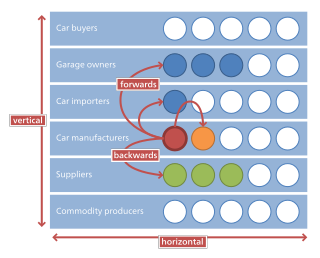
Horizontal integration is the process of a company increasing production of goods or services at the same level of the value chain, in the same industry. A company may do this via internal expansion, acquisition or merger.
In economics, internationalization or internationalisation is the process of increasing involvement of enterprises in international markets, although there is no agreed definition of internationalization. Internationalization is a crucial strategy not only for companies that seek horizontal integration globally but also for countries that addresses the sustainability of its development in different manufacturing as well as service sectors especially in higher education which is a very important context that needs internationalization to bridge the gap between different cultures and countries. There are several internationalization theories which try to explain why there are international activities.
In the field of management, strategic management involves the formulation and implementation of the major goals and initiatives taken by an organization's managers on behalf of stakeholders, based on consideration of resources and an assessment of the internal and external environments in which the organization operates. Strategic management provides overall direction to an enterprise and involves specifying the organization's objectives, developing policies and plans to achieve those objectives, and then allocating resources to implement the plans. Academics and practicing managers have developed numerous models and frameworks to assist in strategic decision-making in the context of complex environments and competitive dynamics. Strategic management is not static in nature; the models can include a feedback loop to monitor execution and to inform the next round of planning.
In business, a competitive advantage is an attribute that allows an organization to outperform its competitors.

Porter's Five Forces Framework is a method of analysing the operating environment of a competition of a business. It draws from industrial organization (IO) economics to derive five forces that determine the competitive intensity and, therefore, the attractiveness of an industry in terms of its profitability. An "unattractive" industry is one in which the effect of these five forces reduces overall profitability. The most unattractive industry would be one approaching "pure competition", in which available profits for all firms are driven to normal profit levels. The five-forces perspective is associated with its originator, Michael E. Porter of Harvard University. This framework was first published in Harvard Business Review in 1979.
In theories of competition in economics, a barrier to entry, or an economic barrier to entry, is a fixed cost that must be incurred by a new entrant, regardless of production or sales activities, into a market that incumbents do not have or have not had to incur. Because barriers to entry protect incumbent firms and restrict competition in a market, they can contribute to distortionary prices and are therefore most important when discussing antitrust policy. Barriers to entry often cause or aid the existence of monopolies and oligopolies, or give companies market power. Barriers of entry also have an importance in industries. First of all it is important to identify that some exist naturally, such as brand loyalty. Governments can also create barriers to entry to meet consumer protection laws, protecting the public. In other cases it can also be due to inherent scarcity of public resources needed to enter a market.
A strategic alliance is an agreement between two or more parties to pursue a set of agreed upon objectives needed while remaining independent organizations.
Global strategy as defined in business terms is an organization's strategic guide to globalization. Such a connected world, allows a business's revenue to not be to be confined by borders. A business can employ a global business strategy to reap the rewards of trading in a worldwide market.
Corporate behaviour is the actions of a company or group who are acting as a single body. It defines the company's ethical strategies and describes the image of the company. Studies on corporate behaviour show the link between corporate communication and the formation of its identity.
International business refers to the trade of goods, services, technology, capital and/or knowledge across national borders and at a global or transnational scale.

In economics, competition is a scenario where different economic firms are in contention to obtain goods that are limited by varying the elements of the marketing mix: price, product, promotion and place. In classical economic thought, competition causes commercial firms to develop new products, services and technologies, which would give consumers greater selection and better products. The greater the selection of a good is in the market, the lower prices for the products typically are, compared to what the price would be if there was no competition (monopoly) or little competition (oligopoly).
A business cluster is a geographic concentration of interconnected businesses, suppliers, and associated institutions in a particular field. Clusters are considered to increase the productivity with which companies can compete, nationally and globally. Accounting is a part of the business cluster. In urban studies, the term agglomeration is used. Clusters are also important aspects of strategic management.
In economics, barriers to exit are obstacles in the path of a firm that wants to leave a given market or industrial sector. These obstacles often have associated costs, prohibiting the firm from leaving the market. If the barriers of exit are significant, a firm may be forced to continue competing in a market. This forced stay in the market occurs when the costs of leaving a market are higher than costs incurred by continuing in the market. Sometimes, when firms operate at low profit or at loss, they still choose to compete with others. Major factors of this decision making is high barriers to exit.
Market environment and business environment are marketing terms that refer to factors and forces that affect a firm's ability to build and maintain successful customer relationships. The business environment has been defined as "the totality of physical and social factors that are taken directly into consideration in the decision-making behaviour of individuals in the organisation."
Technology Intelligence (TI) is an activity that enables companies to identify the technological opportunities and threats that could affect the future growth and survival of their business. It aims to capture and disseminate the technological information needed for strategic planning and decision making. As technology life cycles shorten and business become more globalized having effective TI capabilities is becoming increasingly important.
Innovation management is a combination of the management of innovation processes, and change management. It refers to product, business process, marketing and organizational innovation. Innovation management is the subject of ISO 56000 series standards being developed by ISO TC 279.
For international trade, Foreign market entry modes are the ways in which a company can expand its services into a non-domestic market.
An enterprise planning system covers the methods of planning for the internal and external factors that affect an enterprise.

Strategic competitiveness is accomplished when a firm successfully integrates a value-creating strategy. The key to having a complete value-creating strategy is to adopt a holistic approach that includes business strategy, financial strategy, technology strategy, marketing strategy and investor strategy. The objective of the firm has to be based on creating value in an efficient way because it is the starting point for all businesses and it will generate profit after cost. Eric Beinhocker, the Executive Director of the Institute for New Economic Thinking at the Oxford Martin School, University of Oxford, says in his book The Origin of Wealth that the origin of wealth is knowledge. Knowledge does not have to be perceived as an assumption, or as an external factor. It has to be in the heart of the business. For this reason, the value-creating strategy must include a thorough knowledge of each area of the company in order to develop a competitive advantage.
Cooperative Strategy refers to a planning strategy in which two or more firms work together in order to achieve a common objective. Several companies apply cooperative strategies to increase their profits through cooperation with other companies that stop being competitors.




